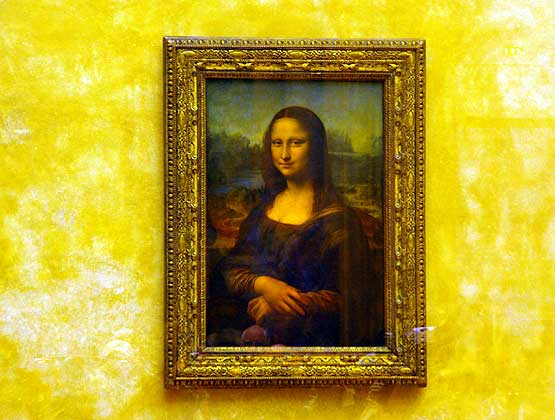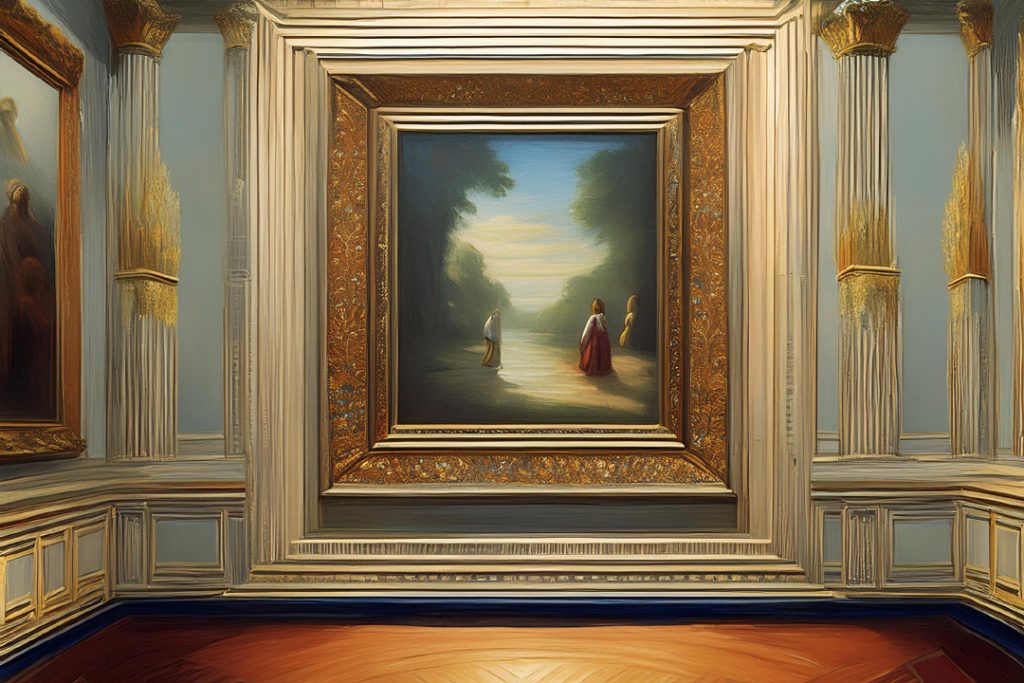Famous Paintings in History
Art is packed with timeless masterpieces that fascinate and inspire folks of all ages. Among the most iconic are the works of Leonardo Da Vinci and Vincent Van Gogh. These legends have created visual wonders that still leave us in awe.
Masterpieces of Leonardo Da Vinci
Leonardo Da Vinci, the Renaissance genius, painted some of the most legendary artworks ever. His pieces are known for their intricate details, innovative methods, and huge impact.
The Mona Lisa

Leonardo’s Mona Lisa is undoubtedly his most famous painting. Finished sometime between 1503 and 1517, it’s known for the subject’s mysterious smile and the enigma of her identity. Many believe she is Lisa Gherardini, wife of a Florence merchant. You can witness this masterpiece at the Louvre Museum in Paris, standing as the most famous and valuable painting in history.
The Last Supper
Another gem by Leonardo is The Last Supper. Painted between 1495 and 1498, this mural captures the moment Jesus reveals one of his disciples will betray him. It’s located in the Convent of Santa Maria delle Grazie in Milan, Italy, and is acclaimed for its depth, perspective, and raw emotion.
Van Gogh’s Iconic Artwork
Vincent Van Gogh, a post-impressionist virtuoso, produced some of the most recognizable and influential paintings. His bold use of colors and distinct brushwork make his art unforgettable.
The Starry Night
Van Gogh’s The Starry Night is an all-time favorite. Created in 1889 while he was in an asylum in Saint-Rémy, France, it mirrors his chaotic state of mind with swirling skies and vivid hues. This gem is kept at the Museum of Modern Art in New York City and remains cherished across the globe.
Sunflowers
Another standout from Van Gogh is his Sunflowers series, painted in 1888 and 1889. These vibrant sunflower vases were meant to jazz up his friend Paul Gauguin’s room. They’re renowned for bold colors and expressive strokes, symbolizing his visionary flair.
| Painting | Artist | Year | Location |
|---|---|---|---|
| Mona Lisa | Leonardo Da Vinci | 1503-1517 | Louvre Museum, Paris |
| The Last Supper | Leonardo Da Vinci | 1495-1498 | Convent of Santa Maria delle Grazie, Milan |
| The Starry Night | Vincent Van Gogh | 1889 | Museum of Modern Art, New York |
| Sunflowers | Vincent Van Gogh | 1888-1889 | Various Locations |
For a deeper dive into the world of art, check out the history of the abstract art movement and get creative with mixed media art techniques.
Learn more about these legendary artists, and let their work inspire you to create your own masterpieces with painting techniques for beginners.
Artistic Creations by Gustav Klimt
Gustav Klimt is the name to know for glitz and glam in art. His pièce de résistance, “The Kiss,” painted in 1907-1908, shines like a diamond. It’s the crown jewel of his Golden Phase where he turned Symbolism into Vienna bling. Inspired by his trip to the Basilica di San Vitale in Italy, Klimt drenched the canvas in gold, turning a simple hug into a timeless treasure.
| Painting | Year | What’s Cool About It |
|---|---|---|
| The Kiss | 1907-1908 | Gold leaf, Symbolism, Vienna Jugendstil |
Klimt had a knack for themes that got tongues wagging: eroticism, love, and the essence of the feminine. This made him a lead player in the Vienna Secession. Want to give Klimt-worthy techniques a whirl? Check out our painting techniques for beginners.
Botticelli’s Renaissance Gem
Sandro Botticelli hit the Renaissance jackpot with “The Birth of Venus,” crafted between 1484-1486. The painting flaunts Venus stepping out of the sea like a boss, reintroducing the full-length nude in a big way (Time Out). Lorenzo de Medici commissioned this beauty, which barely dodged destruction during Savonarola’s art purge.
Botticelli’s mix of myth and detail nail “The Birth of Venus” as a timeless icon of beauty and grace.
| Painting | Year | What’s Cool About It |
|---|---|---|
| The Birth of Venus | 1484-1486 | Mythology, full-length nude |
Got a thing for mixing styles? Hit up our guide on mixed media art techniques and start creating your own Renaissance-meets-modern masterpieces.
Revolutionary Works by Pablo Picasso
Pablo Picasso’s “Les Demoiselles d’Avignon” (1907) didn’t just turn heads; it spun them around completely. This Cubist gem smashed the norms of the art scene with twisted figures inspired by African masks and a nod to El Greco’s layouts (Time Out). Depicting what many think are prostitutes, it’s raw, it’s real, and it catapulted art from past to future.
| Painting | Year | What’s Cool About It |
|---|---|---|
| Les Demoiselles d’Avignon | 1907 | Cubism, African masks, modern composition |
Picasso broke all the rules and in doing so, created a new path for abstract art. Curious about how this all plays out? Dive into the abstract art movement history for the full scoop.
Klimt, Botticelli, and Picasso—these artists painted their way into history with strokes that still ripple through the art scene. By diving into their stories and techniques, you gain a deeper respect for the masters and the enduring magic of their canvases. Explore more of these legendary pieces with our famous paintings in history.
Bold Art: Stirring Up Trouble Through the Ages
Art isn’t just a pretty picture. It’s a medium for shaking things up and pushing boundaries. Throughout history, some pieces have done more than just please the eye—they’ve stirred controversy, challenged norms, and redefined what art even means. Let’s jump into some iconic works that not only left an artistic mark but also raised a few eyebrows along the way.
Masterpieces that Rocked the Boat
Certain artworks are known not just for their beauty, but for the heated debates they sparked. Here are a few that really got people talking:
Fountain by Marcel Duchamp
In 1917, Marcel Duchamp turned the art world on its head with Fountain. He took a plain old urinal, slapped “R. Mutt” on it, and called it art. This bold move made everyone rethink what qualifies as art. The everyday object suddenly had everyone questioning who gets to decide what’s worthy of a gallery (The Collector).
| Artwork | Artist | Year | Controversy |
|---|---|---|---|
| Fountain | Marcel Duchamp | 1917 | Redefined what counts as art |
Les Demoiselles d’Avignon by Pablo Picasso
In 1907, Pablo Picasso introduced Les Demoiselles d’Avignon, shaking things up with its distorted faces inspired by African masks. Picasso’s portrayal of prostitutes in a raw, unfiltered way wasn’t just shock value—it marked a significant leap into modernism. Critics didn’t know what hit them.
| Artwork | Artist | Year | Controversy |
|---|---|---|---|
| Les Demoiselles d’Avignon | Pablo Picasso | 1907 | Radical departure from traditional art forms |
The Dinner Party by Judy Chicago
In the 1970s, Judy Chicago’s The Dinner Party carved out a space for feminist art with its triangular table and plates, featuring symbols of female anatomy. Some critics called it pornographic and offensive; others saw it as a powerful statement on women’s history and sexuality. Either way, it made waves.
| Artwork | Artist | Year | Controversy |
|---|---|---|---|
| The Dinner Party | Judy Chicago | 1970s | Feminist themes and shocking imagery |
Art as a Voice for Politics
Art can also be a megaphone for political messages. Here are some pieces that captured social and political moods of their times:
Guernica by Pablo Picasso
In 1937, Pablo Picasso’s Guernica laid bare the horrors of war. This mural-sized painting depicted the bombing of Guernica during the Spanish Civil War with brutal honesty. It stood as a powerful anti-war statement—screaming justice and making people confront uncomfortable truths (IPaintMyMind).
| Artwork | Artist | Year | Political Message |
|---|---|---|---|
| Guernica | Pablo Picasso | 1937 | Anti-war message, Spanish Civil War |
These controversial pieces are reminders of how potent art can be. They provoke thought, inspire action, and show the tangled relationship between art and society. Dive deeper into this world and learn about other significant movements in our abstract art movement history.
Here are some great online resources to learn about classical paintings and explore online art galleries:
- Smarthistory (smarthistory.org)
- Smarthistory offers free, accessible art history content created by leading scholars. It covers various periods of art, including classical and Renaissance, with essays, videos, and images that span global art history. This is a great starting point for both beginners and experts interested in exploring historical contexts of classical artworks.
- World History Encyclopedia (worldhistory.org)
- This site provides a curated gallery of important Renaissance paintings, featuring artists like Leonardo da Vinci and Michelangelo. You can explore images and read about the historical significance of these works, which helps place classical art in its broader historical context.
- The Art Institute of Chicago (artic.edu)
- The Art Institute of Chicago provides access to over 2 million works of art online, including Renaissance and classical pieces. Their public domain collection allows you to explore high-quality images of these works.
- Open Culture (openculture.com)
- This platform links to various world-class museum collections like the Metropolitan Museum of Art and the Louvre. These museums offer free access to thousands of classical paintings online, making it an excellent resource for exploring major works from different periods.
These sites will give you both educational material and the opportunity to view iconic works of classical art online.
Here some recommended links selected for you: The Best Books of the Month, Todays best Deals at Amazon, Best Sellers in Cell Phones & Accessories and last but not least the easy and great way to send a gift for the holidays: Amazon.com eGift Card (Instant Email or Text Delivery).




